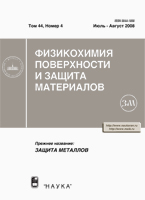Effect of the Milling Conditions for Nanocrystalline Iron Powders on Their Corrosion Behavior in Neutral Electrolytes
S. F. Lomayevaa, A. V. Syugaeva, S. M. Reshetnikovb, A. S. Shuravinb, O. M. Nemtsovaa, and V. V. Aksenovaa
a Physicotechnical Institute, Ural Division, Russian Academy of Sciences,
ul. Kirova 132, Izhevsk, 426000 Russia
E-mail:
Этот e-mail защищен от спам-ботов. Для его просмотра в вашем браузере должна быть включена поддержка Java-script
b Udmurt State University, ul. Universitetskaya 1, Izhevsk, 426034 Russia
E-mail:
Этот e-mail защищен от спам-ботов. Для его просмотра в вашем браузере должна быть включена поддержка Java-script
Received May 26, 2006
Abstract — The corrosion behavior of nanocrystalline iron powders obtained by milling in oxygen-containing organic media (isopropyl alcohol, acetic acid, oleic acid, and its solutions in heptane) was studied. The high corrosion resistances of iron powders obtained by mechanoactivation in oleic acid were associated with a protective surface layer formed by iron oxide and chemisorbed oleic acid or products of its partial degradation. Nanocrystalline iron-based systems that contain oxide phases without forming protective layers were less resistant to corrosion
PACS numbers: 82.45.Yz; 82.45.Bb
DOI: 10.1134/S0033173207020129
